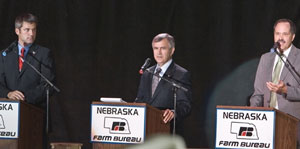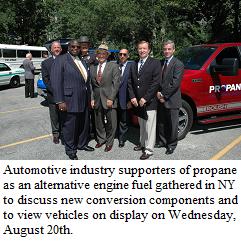 A 20-year veteran of Madison, Wisconsin radio, talk show host Sly – Madison’s Mid-day Maverick, is promoting E85 to and from the Democratic National Convention. Sly is blogging his experience daily.
A 20-year veteran of Madison, Wisconsin radio, talk show host Sly – Madison’s Mid-day Maverick, is promoting E85 to and from the Democratic National Convention. Sly is blogging his experience daily.
“People that know nothing about E85 chant that ridiculous slogan ‘No Food for Fuel’,” Sly said. “Seems to me that America has the space, energy, and talent to grow food and fuel responsibly and hopefully inthe process never have to go back to the Persian Gulf for our sustainability.”
Sly drove from Madison to Denver in his Chevy Suburban fueling up with E85 on the way. “My first fill-up was at Zarco 66. . . . This was the Rosetta Stone of gas stations. Not only did they have E85 but every other possible boutique fuel, even bio-diesel. I even used their environmentally conscience car wash, they probably don’t see many Suburbans venture through there. Again the fuel was much cheaper than standard petroleum. The E85 website has been a big help finding these great stations. Most of them are convenient to the interstates or major highways.”
Sly’s daily blog can be found at http://slystriptodenver.blogspot.com/. His radio show can be heard week days from 10 a.m. – 2p.m. on Madison 1670 The Pulse.


 GreenHunter Biofuels has announced that its Houston biodiesel refinery has hit 50 percent of its 105 million gallon per year capacity at the nation’s largest biodiesel refinery.
GreenHunter Biofuels has announced that its Houston biodiesel refinery has hit 50 percent of its 105 million gallon per year capacity at the nation’s largest biodiesel refinery.
 Doubts about commercial opportunities for cellulosic ethanol are evaporating:
Doubts about commercial opportunities for cellulosic ethanol are evaporating: Hundreds of supporters have been
Hundreds of supporters have been  According to OSU professor of chemical and biomolecular engineering Umit Ozkan, a new catalyst can makes hydrogen from ethanol with 90 percent yield, at a workable temperature, and using inexpensive ingredients.
According to OSU professor of chemical and biomolecular engineering Umit Ozkan, a new catalyst can makes hydrogen from ethanol with 90 percent yield, at a workable temperature, and using inexpensive ingredients. Republican Mike Johanns, Democrat Scott Kleeb and Green Party candidate Steve Larrick all discussed the important issues of energy, climate change and renewable fuels – although most of the sparks flew between Johanns and Kleeb.
Republican Mike Johanns, Democrat Scott Kleeb and Green Party candidate Steve Larrick all discussed the important issues of energy, climate change and renewable fuels – although most of the sparks flew between Johanns and Kleeb. Motorsports legend Jack Roush joined a group of auto company executives, fleet operators and propane marketers to demostrate to the press and public some propane-fueled vehicles in New York City.
Motorsports legend Jack Roush joined a group of auto company executives, fleet operators and propane marketers to demostrate to the press and public some propane-fueled vehicles in New York City. “Aside from its superb engineering, this F-150 is a propane alternative-fueled vehicle that has an established refueling infrastructure to support it,” said Jack Roush, chairman of the board of Roush Enterprises and CEO and co-owner of Roush Fenway Racing, Livonia, Michigan. “It has lower greenhouse gas emissions than gasoline and diesel pickups and costs less to operate, and it contributes to the reduction of America’s dependency on foreign oil.”
“Aside from its superb engineering, this F-150 is a propane alternative-fueled vehicle that has an established refueling infrastructure to support it,” said Jack Roush, chairman of the board of Roush Enterprises and CEO and co-owner of Roush Fenway Racing, Livonia, Michigan. “It has lower greenhouse gas emissions than gasoline and diesel pickups and costs less to operate, and it contributes to the reduction of America’s dependency on foreign oil.”